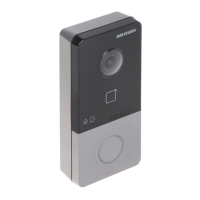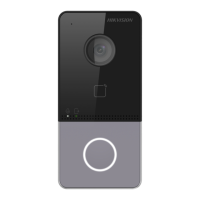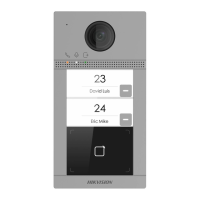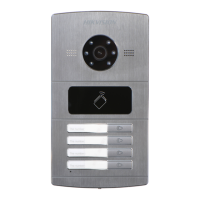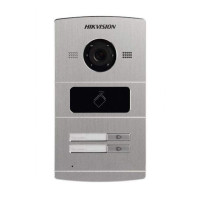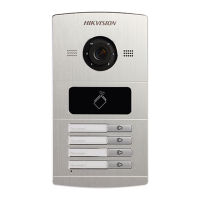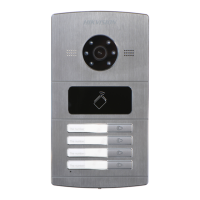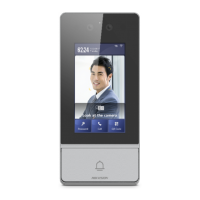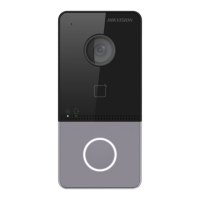
Do you have a question about the HIKVISION DS-KV6113-PE1 and is the answer not in the manual?
| Color | - |
|---|---|
| Wall mountable | Yes |
| Connectivity technology | Wired |
| Megapixel | 2 MP |
| Supported video modes | 720p, 1080p |
| Viewing angle, vertical | 75 ° |
| Maximum video resolution | 1920 x 1080 pixels |
| Viewing angle, horizontal | 129 ° |
| Networking standards | IEEE 802.3af |
| Ethernet LAN data rates | 10, 100 Mbit/s |
| Ethernet interface type | Fast Ethernet |
| Supported network protocols | TCP/IP, RTSP |
| Product color | Black, Grey |
| International Protection (IP) code | IP65 |
| LED type | IR |
| Indoor unit included | No |
| Outdoor unit power type | DC |
| Power consumption (typical) | 10 W |
| Operating temperature (T-T) | -40 - 55 °C |
| Operating relative humidity (H-H) | 10 - 95 % |
| Display diagonal | - \ |
| Operating system installed | Embedded LINUX |
| Depth | 65 mm |
|---|---|
| Width | 138 mm |
| Height | 27 mm |
Provides overview of manual content, usage, and updates.
Lists Hikvision's trademarks and other mentioned trademarks.
Outlines limitations of liability, warranties, and user responsibilities regarding product use.
Indicates a hazardous situation that could result in death or serious injury.
Indicates a potentially hazardous situation that could result in equipment damage or data loss.
Provides additional information to emphasize or supplement important points in the text.
Details critical warnings regarding working temperature, power, wiring, installation, and device behavior.
Details precautions to avoid physical shock, extreme environments, damage, and improper usage.
Explains FCC compliance rules and measures to correct interference.
Details CE marking, WEEE directive, and battery disposal regulations.
Identifies and describes components on the front and rear panels of the door station.
Identifies and describes components located on the bottom panel of the door station.
Illustrates and describes the purpose of each terminal on the door station.
Explains how to wire the door station for door lock operation, including notes on terminal usage.
Illustrates the wiring diagram for connecting a door contact sensor to the door station.
Shows the wiring diagram for connecting an exit button to the door station.
Details the wiring diagram for connecting an external alarm input device.
Introduces the accessory components and their dimensions for installation.
Explains the steps and provides a template for surface mounting the door station without a protective shield.
Outlines the steps for surface mounting the door station with a protective shield, referencing a template.
Provides step-by-step instructions for activating the door station using a web browser.
Explains how to activate the door station using the client software.
Guides users on how to modify network settings like IP address and gateway via client software.
Describes how to access and use the live view feature through the web browser.
Explains how to add, delete, and search user information for the door station.
Details how to link room numbers and SIP numbers for communication.
Covers adding, importing, exporting, and synchronizing device information.
Introduces the section for configuring various device parameters.
Guides on configuring basic information, time settings, DST, and maintenance options.
Covers TCP/IP settings, including DHCP, static IP, and DNS server setup.
Introduces the section for configuring video and audio parameters of the device.
Covers display settings, including image adjustment, WDR, brightness, contrast, saturation, and sharpness.
Covers configuration of event-triggered actions, primarily motion detection.
Covers configuration related to device ID, linked network settings, and time parameters for intercom.
Covers configuration for door parameters, card security, and elevator control.
Covers adding, editing, and deleting devices within the client software.
Provides steps to add an active online device to the client software.
Details how to add a device to the client software using its IP address.
Explains how to add multiple devices simultaneously by specifying an IP segment.
Guides on accessing the live view of the door station through the client software.
Covers creating, modifying, and deleting organizational structures within the client software.
Covers adding, managing, and issuing cards to individuals within the system.
Covers adding, configuring, and applying access permissions to users and devices.
Manages video intercom functions like call logs and notices via the client software.
Offers a QR code to view the device communication matrix, including ports.
Provides a QR code to access common serial port commands for Hikvision devices.

